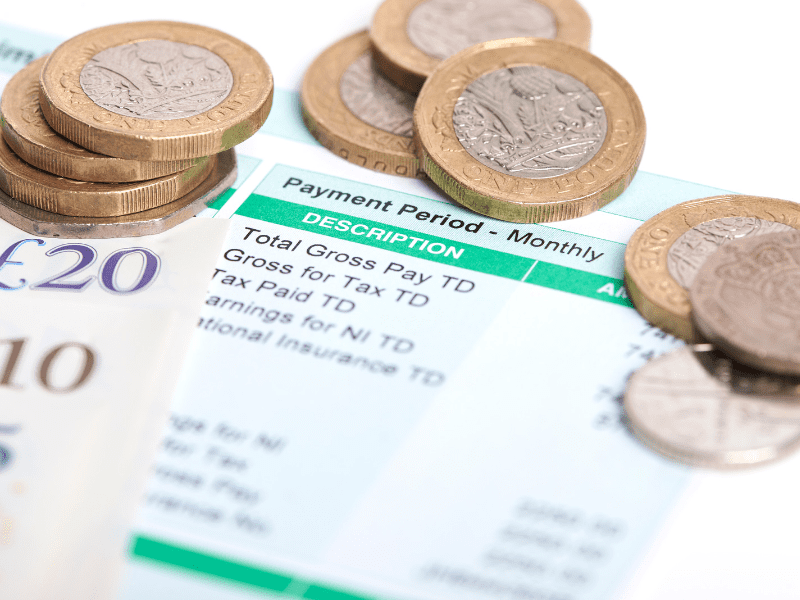
If you’re like most working people, you’re probably anxious about how much money you’re making and where it’s going. That’s why it’s vital to have a payslip – a document that shows you exactly what your income and expenses are for every payday.
This blog post will explain everything you need to know about payslips, including what a payslip includes, how often to check your payslips, where to get a payslip, and more. So let’s dive right in:
What is a payslip?
A payslip is a document showing how much money you earn in a given period. Verifying your income and taxes when applying for jobs or managing finances is essential. It’s also useful when reporting income to the HMRC. So, make sure to keep one handy.
What is included in a payslip?
Your payslip includes all the information you need to accurately report your earnings and deductions. For example, the payslip may list your payroll number, your name, your basic and net pay, deductions, tax period and code, company name, month date etc.
The pay slip also contains essential details about how much you were paid for each hour worked.
How often to check your payslips?
It’s important to keep your payslips accurate and up-to-date. By checking your payslips at least once a month, you can make sure that all income is recorded accurately and that deductions and tax calculations are correct. Also, check the summary for any deductions that may need to be made.
For example, suppose you are receiving statutory pay, like (SPP) Statutory Paternity Pay, (SSP) Statutory Sick Pay, (SMP) Statutory Maternity Pay, and Statutory Shared Parents Pay (SHPP) etc.
In that case, you should check your payslip twice a month. Finally, if there’s a financial change in your situation, like a pay raise or commission, you should also check your payslip.
Should I keep my payslips?
Payslips are an important document for employees, especially if you’re conducting any financial activities like income tax, deduction claims, or claiming benefits. You should keep a copy of your payslips just in case something happens in the future, like errors in earnings or deductions.
Moreover, sometimes banks ask for payslips before offering certain services like a loan or opening specific accounts. If you need payslips for the past months to make copies, you can get them from your payroll provider for the past 22 months.
Make sure you keep all your payslips in a safe place, as they can be valuable documents in the event of an audit.
Why is a payslip important?
As an employee, it’s essential to keep a payslip. It records your earnings and deductions and helps you accurately report income on your taxes. Additionally, it keeps critical information like your pension contributions, National Insurance Contributions, and other deductions.
So make sure to keep a payslip handy and keep it updated as your income and deductions change over the year. In fact, it’s a great idea to have a payslip for each year maintained in a file to avoid any confusion or disputes down the line.
What is a payroll number?
A payroll number is a unique series of numbers that identifies an employee. Almost every company globally assigns payroll numbers to their employees for easy identification.
The purpose of a payroll number is to track the payroll amount, deductions, and other financial information of an employee. It also helps deduct income tax, national insurance, and other social security contributions.
Gross vs Net Pay – Difference?
Payslips are an important financial document, and understanding gross and net pay is essential. Gross pay includes all the wages you earn before taxes, insurance, pension etc., while net pay is what you take home.
For example, if you get a gross income of £60,000 but pay £5,000 in taxes and deductions, your net salary will be £55,000.
It’s important to understand this so that you can accurately report your income on your payslip. Additionally, knowing your take-home pay after various deductions have been made is always helpful. This way, you can plan your budget and save money!
What is basic pay on the payslip?
Basic pay is the mainline salary or another name for gross pay. It is the amount before any additions or deductions.
Different deductions are made from basic pay, such as National Insurance contributions, income tax, and pension contributions.
Bonus payments or commissions may also be included in this figure if they are paid on add-on earnings (i.e. overtime or shift premiums).
Payslip – what does a tax code do?
A tax code consists of a series of letters and numbers that shows the tax-free pay a person will get. For example, the tax code for someone in Northern Ireland and England for 2021/23 is 1257L.
So if we take this tax number as an example, then you will get £12,570 for the month before taxes and deductions. Remember this number as you start filing your taxes, as it may not change till 2026.
If you get a marriage allowance, then the suffix of N or M. The ‘N’ means you have sent up to 10% of your allowance to your spouse. The ‘M’ Suffix shows that your partner has sent you 10% of their allowance.
What’s an emergency tax code?
If you don’t have the correct tax code, don’t worry – there’s a solution! The employer generally uses an emergency tax code when your right tax code is unavailable.
This typically happens if someone starts a new job or if they were self-employed formerly. If that’s the case, your payslip will show a different code for 1-2 months. However, don’t worry – HMRC will automatically correct this issue in due time. Your emergency tax code may appear on the payslip like this:
- 1257 X
- 1257 W1
- 1257 M1
Keep checking your payslip to ensure you’re getting the correct allowance. If you’re ever in doubt, don’t hesitate to ask your employer or accountant for help.
Where to get a payslip?
Payslips are vital for employees, and knowing where to get a copy is important. You’ll automatically get a payslip from your employer, but if you’re with a payroll management organization like Lidertax, then you can ask us to send one your way.
If your company has an in-house payroll management team, you can get a payslip from your organization’s management portal or email address. In the latter case, make sure to check the spam folder first!
Should employers provide a payslip?
Payslips are useful for employees and their employers have a legal obligation to provide payslips to their employees before payday. However, there are a few exceptions to this, including freelancers and contractors.
In addition, some companies may choose not to provide payslips to their employees as part of their company culture. Regardless of the company’s policy, it’s always a good idea to ask for one if you’re not already receiving one.
What to do in case of an issue with my payslip?
No one wants to experience any issues with their payslip, but they know what to do if it does happen.
First and foremost, contact the HR department or line manager if there’s an issue with the pay amount.
If the issue is of statutory things, like tax code, loan payments, pension, or NIC, then you need to contact HMRC. However, don’t panic – it’s all handled hassle-free.




